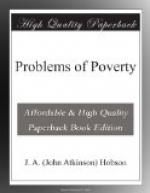It is generally urged that machinery employs as many men as it displaces. This has in fact been the earlier effect of the introduction of machinery into the great staple industries of the country. The first effect of mechanical production in the spinning and weaving industries was to displace the hand-worker. But the enormous increase in demand for textile wares caused by the fall of price, has provided work for more hands than were employed before, especially when we bear in mind the subsidiary work in construction of machinery, and enlarged mechanism of conveyance and distribution. Taking a purely historical view of the question, one would say that the labour displaced by machinery found employment in other occupations, directly or indirectly, due to the machinery itself. Provided the aggregate volume of commerce grows at a corresponding pace with the labour-saving power of new machinery, the classes dependent on the use of their labour have nothing in the long run to fear.
A machine is invented which will enable one man to make as many boots as four men made formerly, displacing the labour of three men. If the cheapening of boots thus brought about doubles the sale of boots, one of the three “displaced” men can find employment at the machine. If it takes the labour of one man to keep up the production of the new machinery, and another to assist in the distribution of the increased boot-supply, it will be evident that the aggregate of labour has not suffered. It is, however, clear that this exactly balanced effect by no means necessarily happens. The expansion of consumption of commodities produced by machinery is not necessarily such as to provide employment for the displaced labour in the same trade or its subsidiary trades. The result of the introduction of machinery may be a displacement of human by mechanical labour, so far as the entire trade is concerned. The bearing of this tendency is of great significance. Analysis of recent census returns shows that not only is agriculture rapidly declining in the amount of employment it affords,




